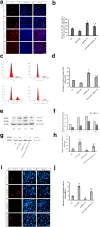Function and mechanism of long non-coding RNA Gm21284 in the development of hippocampal cholinergic neurons
- PMID: 31485323
- PMCID: PMC6716883
- DOI: 10.1186/s13578-019-0336-5
Function and mechanism of long non-coding RNA Gm21284 in the development of hippocampal cholinergic neurons
Abstract
Background: Increasing evidence has revealed that long non-coding RNAs (lncRNAs) play a pivotal role in the development of nervous system. Our previous studies have demonstrated that enhanced cholinergic neurogenesis occurs in the subgranular zone (SGZ) of the hippocampal dentate gyrus (DG) after cholinergic denervation, which is closely associated with the core transcription factor Lhx8. This study aimed to identify novel lncRNAs in a denervated hippocampal niche, which may affect cholinergic neurogenesis, and to explore the molecular mechanisms underlying cholinergic neurogenesis.
Methods: The gene expression profiles of the denervated hippocampus were examined by microarray analysis, and targeted lncRNAs were filtered using bioinformatics analysis. The lncRNA Gm21284 was predicted to be associated with Lhx8. RT-PCR and FISH were used to observe the expression and localization of Gm21284 in vitro and in vivo. The interaction between Gm21284 and Lhx8 and miR-30e-3P was verified using the luciferase reporter gene assay. Cell proliferation and differentiation was observed to reveal the effects of Gm21284 in cholinergic neurogenesis.
Results: Microarray analysis demonstrated 482 up-regulated and 135 down-regulated mRNAs, 125 up-regulated and 55 down-regulated lncRNAs, and 10 up-regulated and 3 down-regulated miRNAs in the denervated hippocampal niche. Overall, 32 lncRNAs were differentially expressed in the denervated hippocampal niche, which could interact with miR-30e-3p, miR-431, and miR-147. Among these 32 lncRNAs, Gm21284 and Adarb1 were identified after interleaving with lncRNAs in a co-expression network and WGCNA. Gm21284 was mainly located in the hippocampal DG. Furthermore, Gm21284-positive cells were considerably increased in the denervated hippocampus than in the normal side. EdU proliferation assay revealed that the proliferation of neural stem cells was repressed after the overexpression of Gm21284. Compared with the control group, the proportion of ChAT-positive cells increased at 7 days of differentiation of NSCs overexpressing Gm21284.
Conclusion: Thus, Gm21284 functions as a competing endogenous RNA, which inhibits the proliferation of hippocampal NSCs and promotes their differentiation toward cholinergic neurons by inhibiting miR-30e-3P competitively.
Keywords: Cholinergic neuron; Development; Hippocampus; NSCs; lncRNA.
Conflict of interest statement
Competing interestsThe authors declare that they have no competing interests.
Figures





Similar articles
-
Non-Coding RNAs in the Regulation of Hippocampal Neurogenesis and Potential Treatment Targets for Related Disorders.Biomolecules. 2022 Dec 22;13(1):18. doi: 10.3390/biom13010018. Biomolecules. 2022. PMID: 36671403 Free PMC article. Review.
-
Microarray expression profiling in the denervated hippocampus identifies long noncoding RNAs functionally involved in neurogenesis.BMC Mol Biol. 2017 Jun 6;18(1):15. doi: 10.1186/s12867-017-0091-2. BMC Mol Biol. 2017. PMID: 28587591 Free PMC article.
-
The role of hippocampal niche exosomes in rat hippocampal neurogenesis after fimbria-fornix transection.J Biol Chem. 2021 Jan-Jun;296:100188. doi: 10.1074/jbc.RA120.015561. Epub 2021 Jan 22. J Biol Chem. 2021. PMID: 33334882 Free PMC article.
-
Lhx8 promote differentiation of hippocampal neural stem/progenitor cells into cholinergic neurons in vitro.In Vitro Cell Dev Biol Anim. 2012 Dec;48(10):603-9. doi: 10.1007/s11626-012-9562-4. Epub 2012 Nov 13. In Vitro Cell Dev Biol Anim. 2012. PMID: 23150137
-
An Overview of Nicotinic Cholinergic System Signaling in Neurogenesis.Arch Med Res. 2020 May;51(4):287-296. doi: 10.1016/j.arcmed.2020.03.014. Epub 2020 Apr 10. Arch Med Res. 2020. PMID: 32279909 Review.
Cited by
-
Identification of MicroRNA-Potassium Channel Messenger RNA Interactions in the Brain of Rats With Post-traumatic Epilepsy.Front Mol Neurosci. 2021 Feb 1;13:610090. doi: 10.3389/fnmol.2020.610090. eCollection 2020. Front Mol Neurosci. 2021. PMID: 33597846 Free PMC article.
-
Regulators of cholinergic signaling in disorders of the central nervous system.J Neurochem. 2021 Sep;158(6):1425-1438. doi: 10.1111/jnc.15332. Epub 2021 Mar 19. J Neurochem. 2021. PMID: 33638173 Free PMC article. Review.
-
The Emerging Roles of Long Non-Coding RNAs in Intellectual Disability and Related Neurodevelopmental Disorders.Int J Mol Sci. 2022 May 30;23(11):6118. doi: 10.3390/ijms23116118. Int J Mol Sci. 2022. PMID: 35682796 Free PMC article. Review.
-
The functions of long non-coding RNAs in neural stem cell proliferation and differentiation.Cell Biosci. 2020 May 29;10:74. doi: 10.1186/s13578-020-00435-x. eCollection 2020. Cell Biosci. 2020. PMID: 32514332 Free PMC article. Review.
-
Non-Coding RNAs in the Regulation of Hippocampal Neurogenesis and Potential Treatment Targets for Related Disorders.Biomolecules. 2022 Dec 22;13(1):18. doi: 10.3390/biom13010018. Biomolecules. 2022. PMID: 36671403 Free PMC article. Review.
References
-
- Hartig W, Saul A, Kacza J, et al. Immunolesion-induced loss of cholinergic projection neurones promotes beta-amyloidosis and tau hyperphosphorylation in the hippocampus of triple-transgenic mice. Neuropathol Appl Neurobiol. 2014;40(2):106–120. - PubMed
-
- McKinney M, Jacksonville MC. Brain cholinergic vulnerability: relevance to behavior and disease. Biochem Pharmacol. 2005;70(8):1115–1124. - PubMed
-
- Oliveira AA, Jr, Hodges HM. Alzheimer’s disease and neural transplantation as prospective cell therapy. Curr Alzheimer Res. 2005;2(1):79–95. - PubMed
-
- Zou L, Jin G, Zhang X, et al. Proliferation, migration, and neuronal differentiation of the endogenous neural progenitors in hippocampus after fimbria fornix transection. Int J Neurosci. 2010;120(3):192–200. - PubMed
LinkOut - more resources
Full Text Sources

